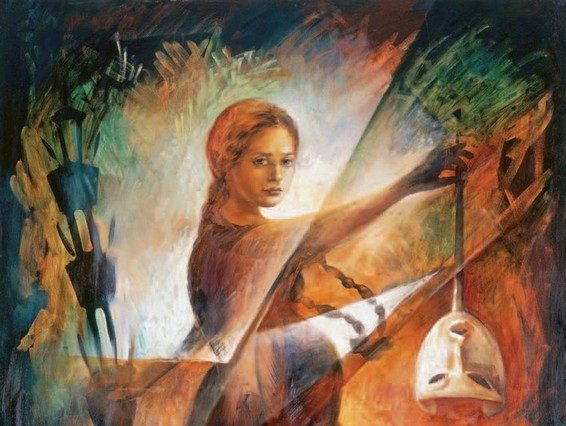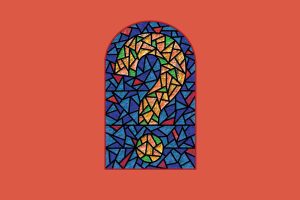When teaching Bible classes in parishes, I often begin with the question, “When I say ‘characters of the Bible,’ what names come to mind?”
The consistency of the list is quite remarkable: Jesus, Paul, Moses, Saul, Solomon, David, Abraham, Isaac, and some of the prophets, such as Isaiah and Jeremiah, figure as regulars among the first responses. The naming continues with the identification of less familiar players: Joshua, Nathan, Joel, Jonah, James, John, and Thomas. It is commendable how many characters surface.
But as the brainstorming dies down, I often note the glaring absence of women’s names from the list. Mustering a response, folks quickly chime in: Mary, Mary Magdalene, Sarah, Rebekah, Rachel, Leah. But then the recitation comes to a halt and a quiet embarrassment settles over the group.
In fact, it is not my students’ fault that the only familiar names of women in the Bible are the Marys of the New Testament and the matriarchs of the Old.
For most people the biblical stories featured in the lectionary readings each week form the basis of their familiarity with the Bible, and, as John Baldovin, S.J. regrettably notes in Bread of Life, Cup of Salvation (Rowman & Littlefield), even in its revisions the lectionary features very few stories about women.
But even those who read and study the Bible on its own might be hard pressed at first to identify biblical women. As we well know, these are patriarchal stories composed and passed down in patriarchal cultures. Not surprisingly men appear as the most conspicuous players and protagonists.
But there are many notable female characters and heroes across scripture.
A few, including Ruth, Esther, and Judith, emerge as especially prominent. That whole books are named after them in a patriarchal setting suggests the magnitude of their greatness. Other women have stories told about them, while still others appear only briefly.
Taken together these female characters reveal the role women played in sustaining and defending the chosen people.
In a family way
Ruth, in the book named after her, emerges as a towering protagonist and unmatched critic of culture, custom, and common sense.
Living in the land of Moab, she and another Moabite woman, Orpah, marry into an Israelite family that fled Israel because of famine. Soon after the story begins, the mother, Naomi, and her two daughters-in-law are all widowed. This new social standing places all of them, but especially old Naomi, among society’s most vulnerable.
Orpah returns to her Moabite family, but Ruth refuses to abandon her mother-in-law and travels with her to Bethlehem, Naomi’s Israelite village.
Like Abraham who leaves his land, Ruth leaves behind the security of what she knows—her family, her culture, her gods, and her land—and travels to a country unfamiliar to her.
But unlike Abraham, Ruth receives no divine promise of land and descendants as incentive. Instead, she clings to Naomi, an old widow at the mercy of a man’s world, declaring, “Wherever you go, I will go, and wherever you reside I will reside. Your people will be my people and your God will be my God” (Ruth 1:16). The magnitude of this profession of solidarity remains unmatched in the biblical tradition.
Once in Bethlehem, Ruth’s initiative—first finding food and eventually securing a new marriage—renews the life of both women.
In the end Naomi, who had succumbed to bitterness in her plight, is transformed by her daughter-in-law’s ingenuity and fidelity. Indeed, Ruth deserves the praise that the women of the village exclaim before Naomi as she cradles her new grandson, Ruth’s son: “Ruth, your daughter-in-law, who loves you, [is] more to you than seven sons” (Ruth 4:15).
Ruth is not alone as a life-sustainer. Tamar, a Canaanite woman, also acts in the interest of life, assuring heirs for her dead husband (Gen. 38).
Little known among biblical characters, Tamar marries an Israelite who dies before they have any children. The brother of the dead man refuses to fulfill his legal responsibility of producing offspring to raise up in the name of his deceased brother, so he dies as well. Judah, the father, refuses to give Tamar his only other son, fearing the same fate will visit him.
So when Judah’s own wife dies, Tamar sets out to fulfill the legal duty that Judah has thus far avoided, providing offspring for her deceased husband through a male relative. Setting aside her widow’s garment, she veils herself as a prostitute. Not recognizing her, Judah has sex with her in exchange for his seal, its cord, and staff pin—signs of his identity and authority—as a pledge.
Later, when word comes to Judah that his daughter-in-law is pregnant, Judah orders her to be burned to death. She confronts him with the symbols of his identity, and he recognizes that she has taken on the obligation he has refused to fulfill: the well-being of the deceased. Well deserved is the praise Judah proclaims of Tamar: “She is far more righteous than I” (Gen. 38:26).
Similarly, the women of Exodus 1–2 demonstrate the determination of less prominent women to inspire us to overcome forces of violence and to cooperate with one another as agents of divine power in sustaining life.
First, two God-fearing midwives, Shiphrah and Puah, disobey the Egyptian pharaoh’s order to kill every male child born to the enslaved Israelite people. Whether these women are Egyptian or Hebrew remains unclear, but the grave consequence they would reap for their defiance of such an oppressive ruler is certain.
Next, Moses’ mother rebels against the Egyptian ruler’s order to throw all male Hebrew babies into the Nile. Instead she hides her son for three months and then prepares an ark-like cradle for him to float among the reeds on the river’s edge.
When the pharaoh’s own daughter and her maidservants find the basket, the princess herself acknowledges that the child is Hebrew and arranges for his sustenance and safety. Instead of handing him over for destruction, she too defies her father and acts to save Moses’ life.
Hence, Israel’s central tradition, the Exodus, does not begin with the great liberator Moses. Instead, a diverse group of women—Hebrew and Egyptian, slave and royal, young and old—act together as instruments of God’s saving power. They cross lines of ethnicity, social standing, and age in the interest of Moses’ life. It is the saving activity of women that heralds the beginning of Israel’s freedom from bondage.
Saviors of the people
Esther’s life-giving story, like Ruth’s, unfolds in a book bearing her name. She also works to bring life to others, but unlike Ruth, who restores a family, Esther saves her whole people.
Though an Israelite, Esther rises to become queen at the Persian court. She first exposes a plot to kill the Persian king and later uses this political edge to intercede with this same ruler. Uncovering the wicked court official Haman’s plot to execute her uncle Mordecai for his failure to bow down to Haman, she also makes known his scheme to destroy all the Jews in Persia. In doing so she not only saves her people but preserves their right to worship Yahweh alone.
Judith, another courageous liberator, also puts her life on the line to protect and liberate her village. The book bearing her name was composed about 100 years before the birth of Jesus. However, the story describes an Assyrian invasion of Israel approximately 400 years earlier.
The destruction of Judith’s small town of Bethulia by the powerful Assyrian forces that have besieged it appears certain. The enemy has called for its surrender and promised to annihilate the citizens living there.
Judith, a pious widow, acts in the face of inescapable destruction. Removing her widow’s garment, she dresses herself graciously and styles her hair in high Greco-Roman fashion. So striking and unbelievable is her appearance that she walks right through the enemy lines uninterrupted and presents herself to Holofernes, the powerful Assyrian commander.
Captivated by her beauty, Holofernes invites her to dine with him, and Judith accepts his overture.
While Judith eats the parched grain (kosher food) she brought along in a bag, Holofernes eats excessively and gets drunk. When he falls at her feet in a stupor, she wastes no time in eliminating his tyranny. Employing the bravest of tactics among ancient warriors, Judith decapitates the Assyrian general with his own sword and puts his head in her bag.
Returning to the city the way she came, Judith carries with her the evidence that Holofernes’ era of violence has ended. Upon hearing the news of their leader’s assassination by a woman, the whole Assyrian army flees. Thus Judith shows herself to have more courage and faith than any of the military leaders in Israel.
Other stories of women in Israel who work to rescue their community from enemy terror appear throughout the biblical tradition but are less well known. In the book of Judges, Jael and Deborah are clear protagonists in the tale of Israel’s victory over the Canaanite threat. While Deborah works as both a prophet and military strategist leading the people in battle, Jael works her salvific action without ever leaving home.
Like Judith, Jael unhesitatingly woos Sisera, the exhausted Canaanite commander, into her tent. Never considering the danger to herself, she takes advantage of her enemy’s need for food and rest. Then while he sleeps, Jael seizes what “weaponry” she has in her domestic surroundings. With tent peg in hand, Jael nails Sisera’s head to the ground and brings an end to the Canaanite oppression.
According to the code of ancient warfare, the death of such a feared warrior as Sisera at the hands of a woman deals a humiliating blow to the enemy and earns greater safety for vulnerable Israel. Indeed she is worthy of the commendation with which the Bible praises her, “Blessed be Jael by women” (Judg. 5:24).
Foreign friend
Like Jael, Rahab works within the confines of her domestic sphere to bring about salvation for a people that are not even her own.
Unlike Jael, the Bible introduces her as a Canaanite. Known as Rahab “the harlot” in the tradition, she provides lodging for Israelite spies who have come to case out Jericho before the Israelites enter the Promised Land.
It is worth noting that Josephus, a Jewish historian of the first century, refers to her as “Rahab, the innkeeper.” In the patriarchal world of the Bible it was highly irregular for a woman to run a business. Hence, the pejorative title “harlot” in the biblical story may have been a way of drawing a ring of suspicion around such an enterprising woman.
The king of Jericho seems to have no qualms about communicating with Rahab, though. He requires her to turn over the spies.
In response, Rahab feigns ignorance, saying that the men had departed. In the meantime she hides the agents beneath bundles of flax on her roof and alerts them when it is safe to depart. As they are leaving, Rahab confesses her belief in Israel’s God and appeals for mercy when Israel attacks.
Her courage, forthrightness, and faith win Rahab and her household protection. Moreover, the bravery and political savvy of this woman advance the salvation of the Israelite people. Her name figures among the few women in Matthew’s genealogy of Jesus’ ancestry, suggesting the honor with which she was regarded.
Thus even women with “questionable” reputations, along with so many other commendable mothers, queens, maidservants, and women religious leaders of our biblical traditions, offer important lessons about the different ways God acts in the midst of humanity.
Such stories of courage, determination, commitment, and holiness are waiting to be read and preached from a revised lectionary. Failing to do so not only deprives us all of the lessons taught by the heroism, courage, and self-sacrifice of those who are not front and center in these tales, it also diminishes our ability to recognize and honor their counterparts in our own times.
How we read and interpret the stories of such an important book as our Bible is closely related to how we “read” and take seriously the stories of all the people of our world. In our ever-shrinking global village, the urgent need to better understand and embrace the many and diverse women and men of the human community needs little explanation.
Image: Wikimedia Commons














Add comment